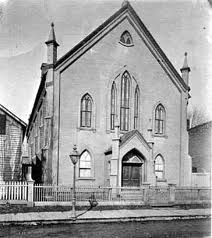 Michigan’s oldest black congregation, the Second Baptist Church, was founded in 1836 by thirteen former slaves. In 1839 the congregation established the city’s first school for black children. Second Baptist’s first pastor, the Reverend William C. Monroe, was a noted anti-slavery activist. In 1843 Monroe presided over the first State Convention of Colored Citizens, which met at the Second Baptist Church. During the meeting, delegates demanded an end to slavery and the right to vote. Numerous black leaders in antebellum America were associated with the church, including Frederick Douglass. In the years prior to the war, the church served as a stop along the underground railroad.
Michigan’s oldest black congregation, the Second Baptist Church, was founded in 1836 by thirteen former slaves. In 1839 the congregation established the city’s first school for black children. Second Baptist’s first pastor, the Reverend William C. Monroe, was a noted anti-slavery activist. In 1843 Monroe presided over the first State Convention of Colored Citizens, which met at the Second Baptist Church. During the meeting, delegates demanded an end to slavery and the right to vote. Numerous black leaders in antebellum America were associated with the church, including Frederick Douglass. In the years prior to the war, the church served as a stop along the underground railroad.
Today, the Emancipation Proclamation is publicly read for the first time in Detroit in the Second Baptist Church, followed by discussion. Resolutions are then passed. In one resolution, attendees declare, “when in the course of human events, there comes a day which is destined to be an everlasting beacon light, marking a joyful era in the progress of a nation and the hopes of a people, it seems to be fitting the occasion that it should not pass unnoticed by those whose hopes it comes to brighten and to bless.” Those present also pass a resolution “stating black readiness for military service.”
In the years of war to come, black soldiers in the United States army will play a vital role in defeating the Confederate States of America.
The Second Baptist Church of Detroit remains to this day, one of the great historical black churches in America.
Sources: “Michigan Historical Marker: Second Baptist Church” (link); “Second Baptist Church of Detroit” (link); Michigan Civil War Monuments, Second Baptist Church (link); Hettie Jones, Jacqueline L. Tobin, From Midnight to Dawn: The Last Tracks of the Underground Railroad, New York: Doubleday, 2007, p. 211 (link); Historical sketch, Second Baptist Church (link); Second Baptist Church of Detroit, National Park Service (link); photograph (link)


